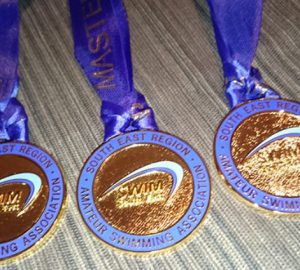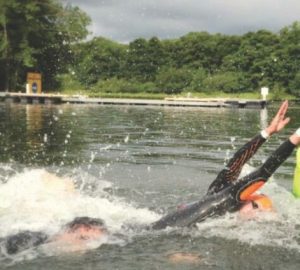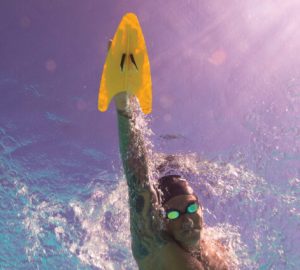Conquer the outdoor swimming marathon
Are you ready to swim a marathon? Progressing to 10km needn’t be a daunting task if you structure your training and ensure that your technique is as efficient as possible.
Reader Zoe Ward swam competitively as a child but at university gave up swimming to concentrate on running and triathlons. She got into outdoor swimming when she had to give up running after having children. “I swam in open water once a week at Cromhall Quarry dive centre for a few years (including over the winter), and in 2016 decided to do some open water events.”
This year Zoe entered the Henley Mile Suits vs Skins event. “I loved it! I was pleasantly surprised by my finishing position and this inspired me to enter the 3.3km Swim Serpentine event in September. As part of my training over the summer I took my family on swimming adventures to rivers and hidden beaches, which has been the highlight of our year.”
With a 3.3km race under her belt, Zoe is now ready to up her distance to 10km. Zoe won our competition for a place at open water swimming festival BEST Fest in Mallorca and she has also entered the 10km Jubilee River Swim in the Thames, so has two opportunities to take on the marathon distance.
Here are our seven steps to conquering the outdoor swimming marathon.
Step 1: Review your swimming technique
As someone with a reasonable swimming background, our assumption is that you will be planning to swim front crawl. Your previous longest open water swim is 3.3km, so 10km represents a significant jump. This means you will want to ensure you swim as efficiently as possible. You also want to avoid any injuries that may be caused by poor technique. Therefore, if you haven’t done so already, and definitely before you ramp up your training, review your swimming technique. Firstly, check out some of our previous articles on front crawl technique (see links below) so that you know what you are aiming for. Then, if possible, ask an experienced coach to take a look at how you swim and ideally do a video analysis.
You won’t be able to fix all weaknesses in your swimming technique in one go (or even ever) but make a start on the journey of continuous improvement.
Step 2: Minimise your risk of injury
Any increase in training puts you at risk of injury and that could be your biggest obstacle to success. There’s no point in training hard for two months and then having to rest and recover from an injury. Try to spend a few minutes each day on some basic shoulder strengthening and posture exercises. Also, consider adding a core strength routine to your training once or twice per week.
As you increase your swimming training, do so gradually. Always ensure you warm up before swimming hard, swim with good technique and occasionally switch to another stroke.
Step 3: Check your diet
Just because you’re exercising more doesn’t give you licence to eat what you like. At the same time, we know swimmers love cake and you won’t want to deny yourself all of life’s pleasures. Try to be conscious of what you eat and avoid too many sugary snacks and drinks. If you mostly eat healthily, then the occasional piece of cake will be fine.
Step 4: Start training
For a 10km swim, we’d recommend a minimum of three training sessions a week with two of one hour and one of 90 minutes to two hours. If this is significantly more than you do already, then use January and February to build up to this. You should be mindful of your technique whenever you swim but we suggest you dedicate one session each week where you make technique your primary focus. The long session each week is your opportunity to cover increasing distances. Aim to do repeats of perhaps 200m to 800m at a steady pace with short breaks. Maintain the same pace throughout the swim or increase pace towards the end. Your third session each week should focus on shorter distances (25m to 200m) where you can work at your critical swim speed (CSS – see link below). If you want to swim more than three times a week that’s great. We’d suggest keeping additional sessions focused on technique and swimming at an aerobic pace.
Step 5: Review your progress
Use a watch or pace clock for all of your sessions and keep a record of how fast you swim. Also, ask someone to measure your stroke rate (strokes per minute) and count your strokes per length from time to time. If you can increase your stroke rate while maintaining your stroke count, you will go faster. If you can reduce your stroke count while maintaining your stroke rate, you will also go faster. Check these measures every two to three weeks to understand how well your training is going. Also, get a second stroke analysis to see if your technique changes have stuck and find out what to work on next.
Step 6: Add in some open water skills
As you get closer to your swim, you should do some sessions outside. If you’re not going to be wearing a wetsuit you need to acclimatise. If you are, you need to get used to swimming in one. Practise sighting and swimming in a straight line primarily. If you’re going to use it as a race tactic, practise drafting.
Step 7: Taper and rest
As you get to within two to three weeks of your swim you should gradually reduce your training volume (but not frequency). This is known as tapering and allows you to fully benefit from the training you’ve been doing. Try to rest and sleep lots (we know this isn’t easy if you have a busy job and small children but do what you can – and don’t beat yourself up about it if you can’t). Eat well but not excessively.

Zoe’s questions
Should I do the 10k swim at BEST Fest?
It depends how much training you’ve done and how fit you are. A 10km swim can really take it out of you. On the other hand, swimming 10km in Mallorca might be too good an opportunity to miss. If you do decide to do it, take it steady, have an energy gel or energy drink during the swim and eat a good, healthy meal afterwards. Do a short, easy swim the next day and don’t do any more hard swimming before the Jubilee swim.
How can I make the best of BEST?
Firstly, just enjoy the experience and soak up the atmosphere. You could practise your racing skills in one of the shorter events and use the longer events to build confidence and practise your nutrition strategy. Wetsuits are optional at BEST but if you want to be included in the race rankings you need to go without. Perhaps do the races without and the sight-seeing swims with? The other great thing about BEST Fest is the opportunity to swim in their 50m pool and get some last minute coaching advice.
What are the differences between swimming 10k at BEST Fest and in the Jubilee River?
The 10k at BEST is a continuous 10k swim in the sea around a buoyed course. The Jubilee is a downstream river swim punctuated by three locks where you have to get out and walk. This breaks up the swim, gives you a chance to catch your breath and grab a bite to eat so makes the distance seem more manageable. On the other hand, the BEST swim is in the sea (where you benefit from additional buoyancy but may have to deal with rougher conditions) and will most likely be a good few degrees warmer.
Do I have to swim 10km in training?
Just has you don’t have to run 26 miles in training before doing a marathon you don’t need to do 10km in training before a 10k marathon swim. We’d recommend that the total distance of some of your training sessions exceeds 5km but you don’t need to do this as a continuous swim. If you can do one or two training sessions of around 7km this will really boost your confidence but it isn’t essential.
Follow Total Immersion's six steps to better freestyle
An overview of the entire freestyle stroke, highlighting how everything you do affects something else. Think of the body as a system, but improve by isolating and focusing on specific parts.
2. Arm recovery
Recovery is not just about getting your arm back to the starting point of the cycle, it is critical for balance and stroke efficiency.
Learn where and when your hand should enter and exit the water.
4. Breathing
Correct breathing technique and how to master bilateral breathing.
Once your technique is perfected, it is time to start getting faster.
6. Rough open water conditions
How to cope and keep calm in adverse conditions.







